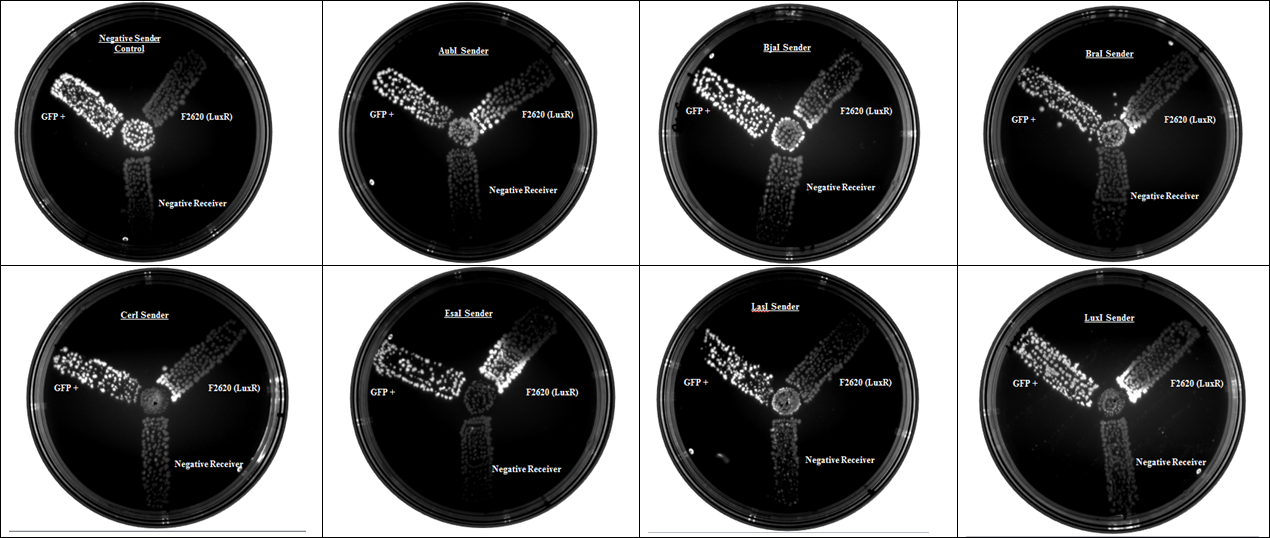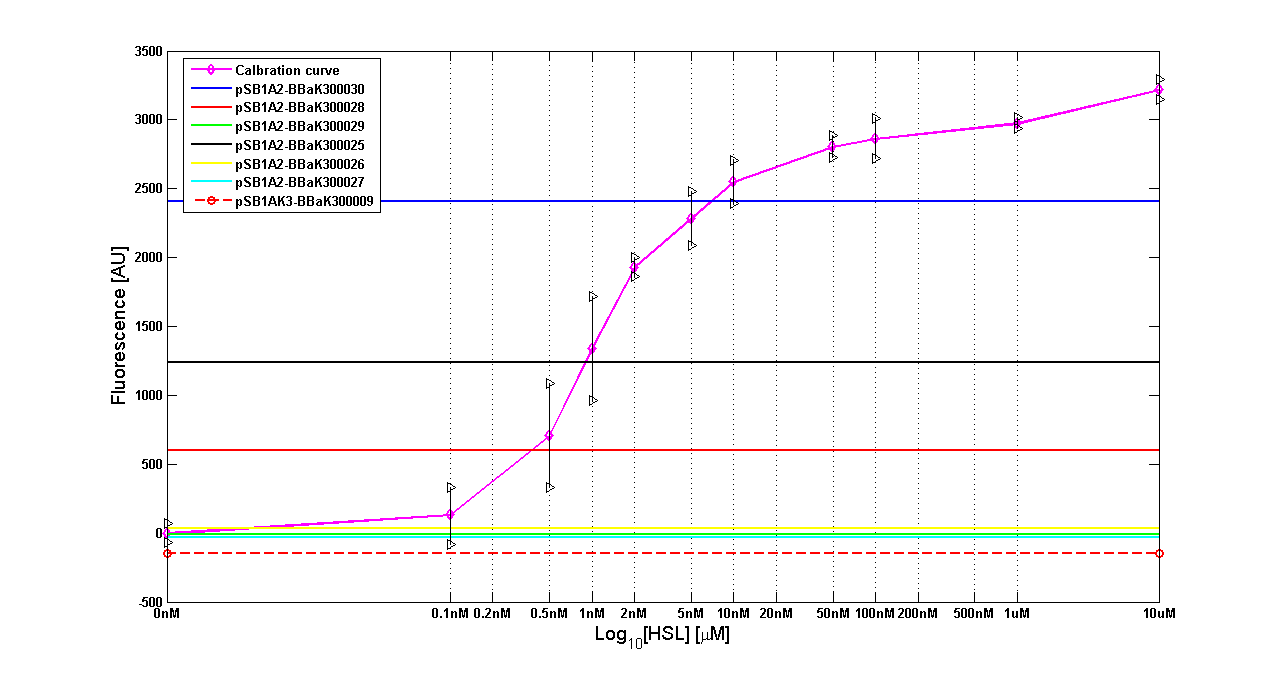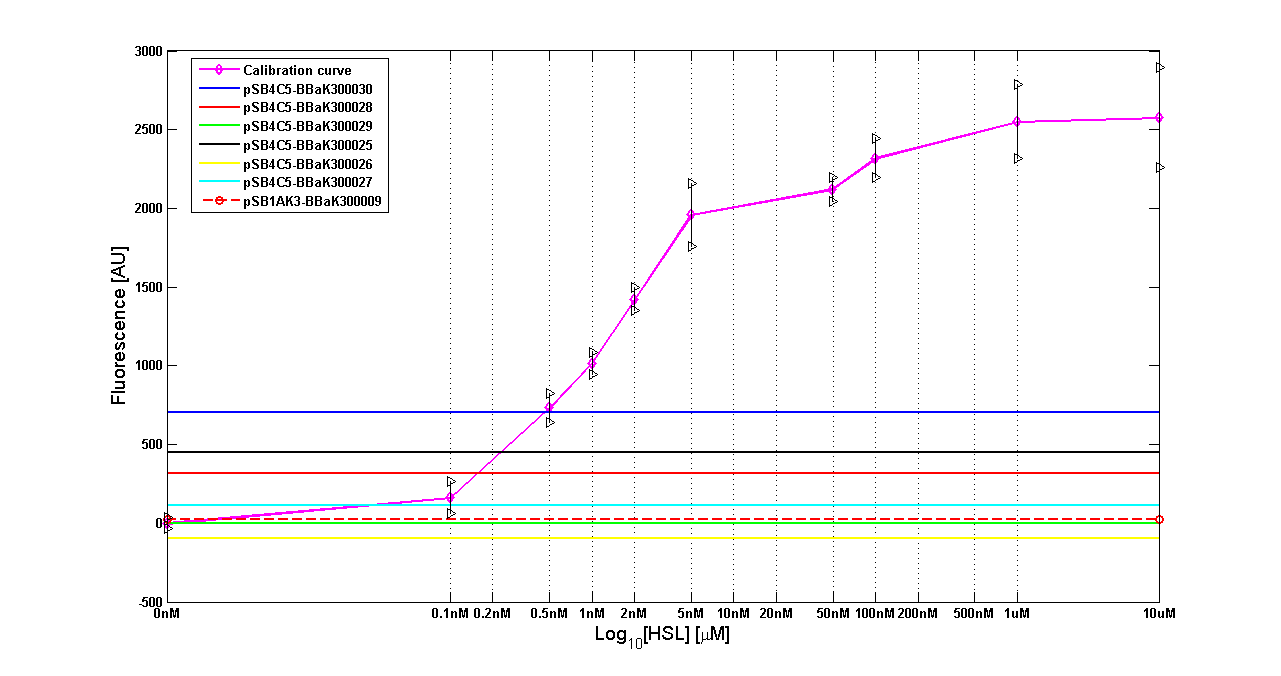Part:BBa_F2620:Experience
|
|
Endy Lab Characterization
We (Barry Canton, Anna Labno, Drew Endy) have measured four characteristics of BBa_F2620. Protocols and results for the four characteristics are linked below. For the purposes of characterization, we connected BBa_E0240 downstream of BBa_F2620 to make the composite part, BBa_T9002. This allowed us to measure the PoPS output from BBa_F2620 indirectly via the fluorescence output of BBa_E0240. Data processing is described here. The data resulting from these experiments is summarized on the paper datasheet.
Leakiness
See Part:BBa_I13556 for more characterization of F2620 upstream of mCherry instead of GFP. In particular, it was found that when grown in LB, there was strong leaky expression of mCherry in the absence of AHL. There was no leaky expression when grown in EZ rich medium. --Austin 17:11, 6 September 2007 (EDT)
F2620 in front of GFP and F2620 in front of lacZa were also both grown up in LB to stationary phase (without AHL) and both of these in addition to the mCherry also showed leaky expression not present when grown in EZ media. --Austin 17:38, 14 April 2008 (EDT)
Quality control
This part was inconsistent in 2009 DNA Distribution. The UNIPV-Pavia iGEM 2009 team requested this part to iGEM Headquarters, sequenced it and found that sequence was correct.
BBa_F2620 - 3OC6HSL receiver device - UNIPV-Pavia TEAM (Test performed by L. Pasotti, S. Zucca)
Description
This device gives PoPS as output and can be induced with 3OC6-HSL autoinducer molecule: it binds luxR protein (encoded by BBa_C0062), which is constitutively expressed by tetR promoter (BBa_R0040). LuxR-HSL complex can work as a transcriptional activator for lux promoter (BBa_R0062).
Several studies have been performed on this BioBrick. Here we provide the experimental characterization we performed during this summer. The tests have been performed through BBa_T9002 measurement system, which has a GFP protein generator downstream.
Characterization
Compatibility: E. coli TOP10 in pSB1A2.
| 3OC6-HSL concentration |
LB | M9 supplemented | ||
| Doubling time [minutes] | RPU mean [range] | Doubling time [minutes] | RPU mean [range] | |
| 0nM | 36 | ~0 | 59 | ~0 |
| 0.1nM | 37 | ~0 | 65 | 0.03 [~0; 0.19] |
| 1nM | 40 | 0.86 [ 0.82 0.92] | 65 | 1.19 [0.53; 3.08] |
| 10nM | 43 | 4.44 [3.81; 5.44] | 73 | 4.29 [2.63; 7.83] |
| 100nM | 43 | 4.53 [3.88; 5.18] | 76 | 5.23 [3.21; 9.28] |
| 1uM | 39 | 3.53 [3.35; 3.75] | 73 | 4.99 [3.14; 8.45] |
| 10uM | 41 | 4.04 [3.56; 4.57] | 62 | 5.40 [3.39; 9.56] |
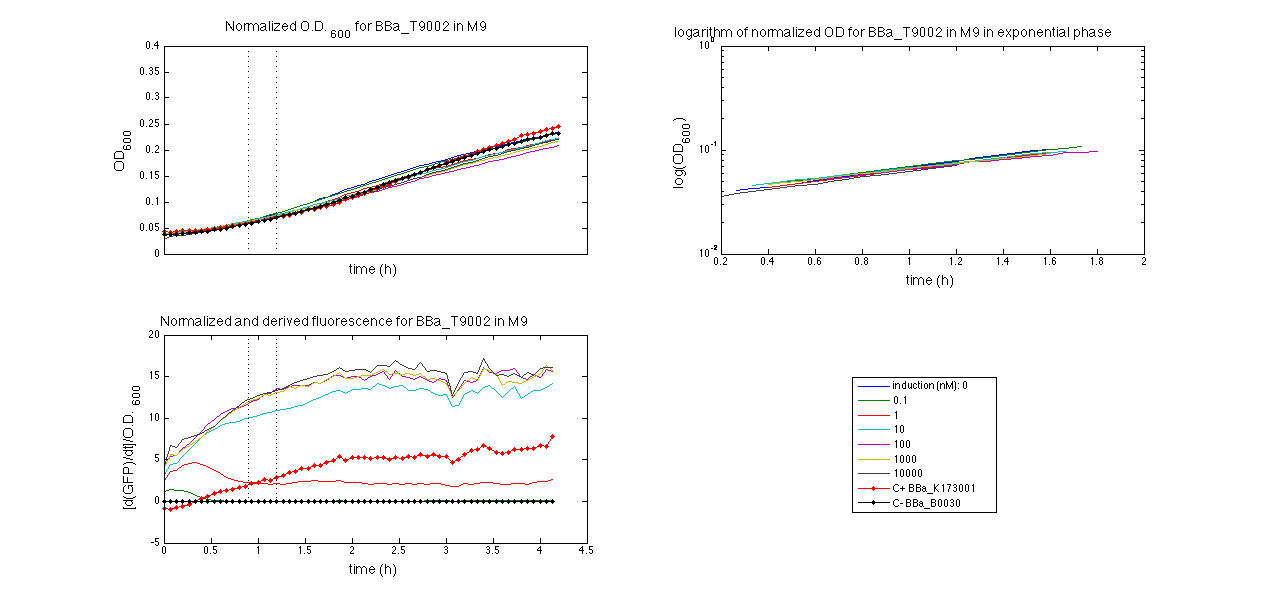 BBa_T9002 Growth curves for 3OC6HSL in M9 |
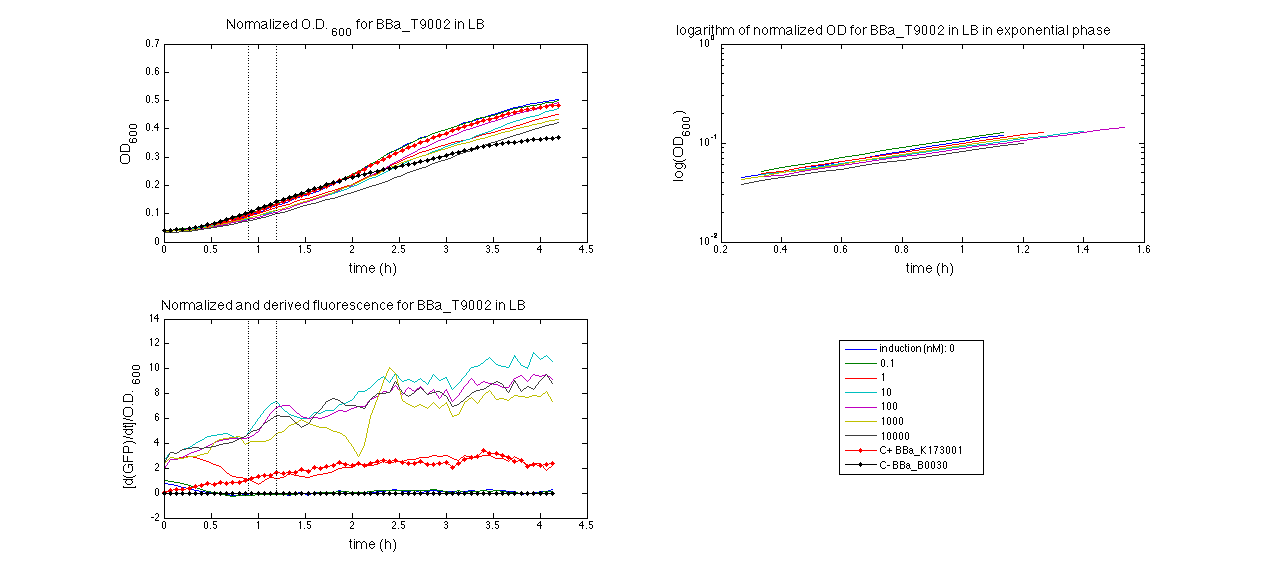 BBa_T9002 Growth curves for 3OC6HSL in LB |
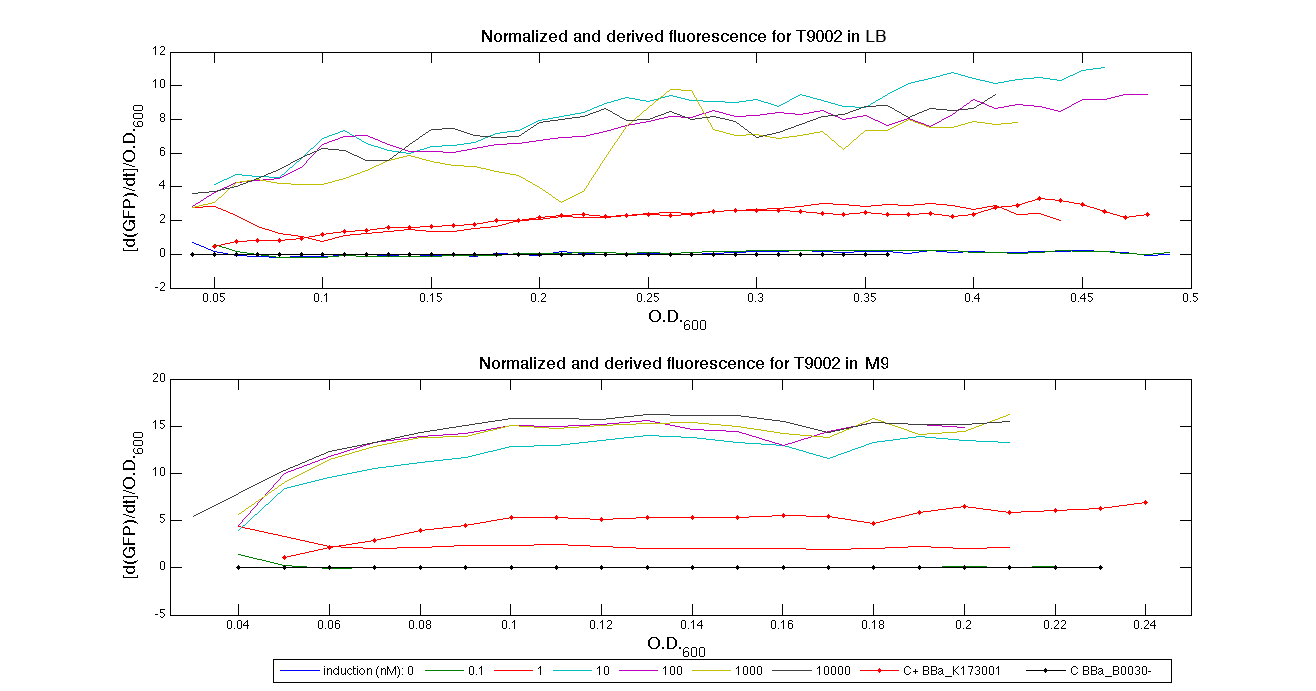 BBa_T9002(dGFP/dt)/O.D. in LB and M9 |
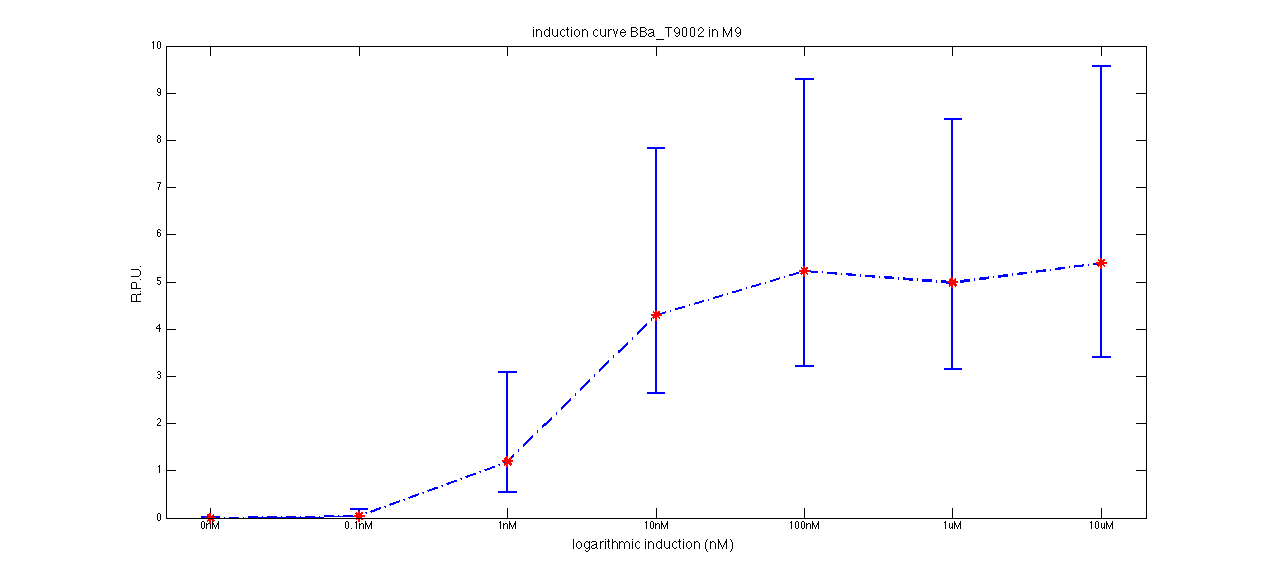 BBa_T9002 Characterization of part in M9 |
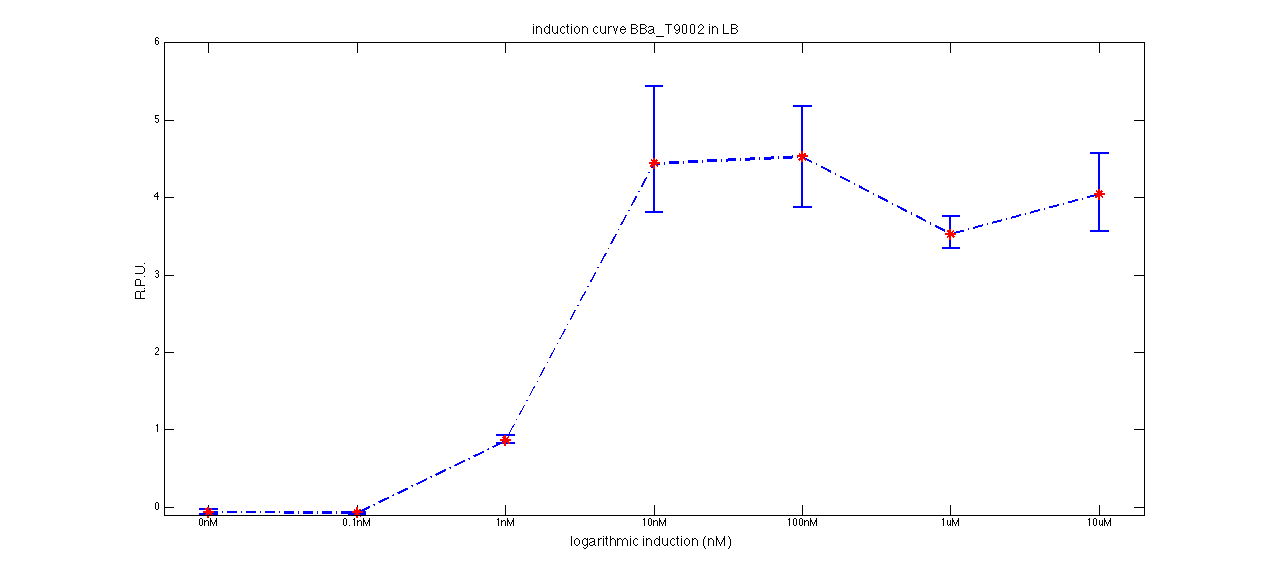 BBa_T9002 Characterization of part in LB |
Conclusions
The induction curve of the receiver device, reported in BBa_F2620 page (M9 supplemented medium), was represented in PoPS units, while ours is reported in RPUs and has been obtained through a very similar protocol (see Growth conditions section). Anyway, the experiments we performed in M9 supplemented medium confirmed the induction curve shape of this device, with a switch point between 1nM and 10nM.
We also estimated the transfer function of this device in LB medium, for which no data were reported in the Registry from previous characterization. More experiments sholud be perfomed on the behaviour of this device in M9 because the one performed show a great variation in RPU range.
Growth conditions
Microplate reader experiments
- 8 ul of long term storage glycerol stock were inoculated in 5 ml of LB + suitable antibiotic in a 15 ml falcon tube and incubated at 37°C, 220 rpm for about 16 hours.
- The grown cultures were then diluted 1:100 in 5 ml of LB or M9 supplemented medium and incubated in the same conditions as before for about 4 hours.
- These new cultures were diluted to an O.D.600 of 0.02 (measured with a TECAN F200 microplate reader on a 200 ul of volume per well; it is not comparable with the 1 cm pathlength cuvette) in a sufficient amount of medium to fill all the desired microplate wells.
- These new dilutions were aliquoted in a flat-bottom 96-well microplate, avoiding to perform dynamic experiments in the microplate frame (see [http://2009.igem.org/Team:UNIPV-Pavia/Methods_Materials/Evaporation Frame effect section] for details). All the wells were filled with a 200 ul volume.
- If required, 2 ul of inducer were added to each single well.
- The microplate was incubated in the Tecan Infinite F200 microplate reader and fluorescence (when required) and absorbance were measured with this automatic protocol:
- 37°C constant for all the experiment;
- sampling time of 5 minutes;
- fluorescence gain of 50;
- O.D. filter was 600 nm;
- GFP filters were 485nm (ex) / 540nm (em);
- 15 seconds of linear shaking (3mm amplitude) followed by 10 seconds of waiting before the measurements in order to make a homogeneous culture.
- Variable experiment duration time (from 3 to 24 hours).
Data analysis
Growth curves
All our growth curves have been obtained subtracting for each time sample the broth O.D.600 measurement from that of the culture; broth was considered in the same conditions of the culture (e.g. induced with the same inducer concentration).
Doubling time
The natural logarithm of the growth curves (processed according to the above section) was computed and the linear phase (corresponding to the bacterial exponential growth phase) was isolated by visual inspection. Then the linear regression was performed in order to estimate the slope of the line m. Finally the doubling time was estimated as d=ln(2)/m [minutes].
In the case of multiple growth curves for a strain, the mean value of the processed curves was computed for each time sample before applying the above described procedure.
Relative Promoter Units (RPUs)
The RPUs are standard units proposed by Kelly J. et al., 2008, in which the transcriptional strength of a promoter can be measured using a reference standard, just like the ground in electric circuits.
RPUs have been computed as:
in which:
- phi is the considered promoter and J23101 is the reference standard promoter (taken from Anderson Promoter Collection);
- F is the blanked fluorescence of the culture, computed subtracting for each time sample fluorescence measure for negative control from that of culture, where the negative control is a non-fluorescent strain (in our experiment it is usually used TOP10 strain bearing BBa_B0032 or BBa_B0033, which are symmply RBSs do not have expression systems for reporter genes);
- ABS is the blanked absorbance (O.D.600) of the culture, computed as described in "Growth curves" section.
RPU measurement has the following advantages (under suitable conditions)
- it is proportional to PoPS (Polymerase Per Second), a very important parameter that expresses the transcription rate of a promoter;
- it uses a reference standard and so measurements can be compared between different laboratories.
The hypotheses on which RPU theory is based can be found in Kelly J. et al., 2008, as well as all the mathematical steps. From our point of view, the main hypotheses that have to be satisfied are the following:
- the reporter protein must have a half life higher than the experiment duration (we use GFPmut3, BBa_E0240, which has an estimated half life of at least 24 hours, and the experiments duration is always less than 7 hours);
- strain, plasmid copy number, antibiotic, growth medium, growth conditions, protein generator assembled downstream of the promoter must be the same in the promoter of interest and in J23101 reference standard.
- steady state must be valid, so (dF/dt)/ABS (proportional to the GFP synthesis rate per cell) must be constant.
Inducible systems
Every experiment is performed on the following cultures:
- the culture of interest (system studied expressing GFP)
- the benchmarck used to evaluate R.P.U. (BBa_K173001 measurement part, that is BBa_J23101 with BBa_E0240 downstream)
- a negative control (generally, BBa_B0033 RBS)
For inducible systems several plots are reported. The first plot is a panel containing 4 subplots, numerated this way:
| (1) | (2) |
| (3) |
Plot (1) contains growth curves of the cultures, after blank value has been removed. Every curve is calculated averaging on three replicates of the same culture and subtracting the blank for each time sample. Blank is calculated averaging the replicates of blank wells.
Plot (2) shows the logarithm of absorbance in exponential phase of bacterial growth, determined by a visual inspection of log-plots. These values are used to evaluate doubling time and R.P.U..
Plot (3) contains (dGFP/dt)/O.D., the value named S_cell in Kelly J. et al., 2008 procedure for RPU evaluation.
In these plots are reported black veritcal lines that define the range of values used to evaluate RPU. It is important to underline, as explained in next paragraph, that RPU are calculated on cultures at the same O.D. level, not at the same time.
The second graphic shows S_cell VS O.D.. This plot allows the conparison of S_cell values between different cultures, that are supposed to reach the same level of growth not at the same time, but at the same O.D. value.
The third graphic shows the induction curve. The RPU value is calculated on S_cell values corresponding to O.D. values in exponential phase (typically, from 0.05 to 0.16). The curve is obtained averaging in time S_cell values corresponding to exponential phase.
Error bars rapresent the minimum and maximum value of R.P.U. belonging to the range of O.D. in exponential phase.
Materials
- Long term glycerol stocks were stored at -80°C with a final glycerol concentration of 20%
- Antibiotics were: Ampicillin (Amp) 100 ug/ml stored at -20°C in 1000x stocks. Amp was dissolved in water.
- LB medium was prepare with: 1% NaCl, 1% bactotryptone, 0.5% yeast extract. The medium was not buffered with NaOH.
- M9 supplemented medium was prepared according to: [http://openwetware.org/wiki/Knight:M9_supplemented_media Openwetware protocol].
- 3OC6-HSL (Sigma) was dissolved in water and stored at -20°C in a 2mM stock.
BBa_F2620 - Inductions Test: Arizona_State 2016
Authors: Ernesto Luna, Brady Dennison, Cassandra Barrett, Jimmy Xu, Jiaqi Wu, Dr. Karmella Haynes
This device outputs PoPS in response to activation by the 3-oxo-C6-HSL molecule. Our team ran a series of induction tests on AHL Senders using F2620 as a reporter device. Ten systems (Aub, Bja, Bra, Cer, Esa, Las, Lux, Rhl, Rpa, Sin) were examined through both a visual plate induction test as well as a 8-hour optical density test measuring GFP production.
Induction Tests
The following visual plate inductions were done using 10 different AHL Senders. These were plated alongside a GFP positive control, a negative Sender control, and F2620 in BL21 E. coli and then imaged after 24 hours.
From these results, it can be shown that 8/10 systems induced F2620, with Las and Sin being the two exceptions. Las was shown to induce by the Canton Lab(2008), so the lack of induction could be due to a molecular diffusion issue. Fluorescence found in the middle of the plate by the Senders themselves was likely due to mCherry production, which was constitutively produced alongside the AHL. A more comprehensive induction test using a plate reader was done afterwards to test these results. Of the 8 systems that induced F2620, Esa showed the greatest level of induction, even greater than that of the native system Lux. This is likely due to the fact that Esa and Lux produce the same AHL molecule and the Esa construct may be more capable of efficient AHL production than that of Lux. The images gathered suggest that many of these systems are not entirely orthogonal to Lux, and that some degree of crosstalk will occur between these networks. SinI remains the top candidate for orthogonality with F2620.
An 8-hour OD reading was done on 10 F2620+Sender samples as well as 5 F2620+Synthetic Sender samples. The generated growth curves are shown below:
Synthetic AHLs
Inductions of Bba_F2620 using naturally produced AHLs (BL21 E. coli chassis) were done at two different AHL concentrations (10% and 50% AHL solution) and were measured over an 8-hour period for GFP production. The curves produced are corrected The figures are sorted by acyl tail structure within the AHLs. 3-oxo-AHLs produced by Esa, Las and Lux systems were all shown to induce F2620, with Las showing the weakest level of interaction (which is supported by the weak induction plate from the previous experiment. Of the non-3-oxo AHLs, Cer and Rpa strongly induced F2620, while Aub, Bja, Bra, and Rhl all seem to induce F2620 very weakly. The only remaining candidate for a truly orthogonal system is Sin; however, because SinI is able to 6 different variants of AHLs, it is possible that E. coli lacks the acyl-carrier proteins necessary to produce all 6 variants, meaning crosstalk is still possible. This will likely require an in-depth characterization on the AHLs capable of being produced by SinI in E. coli.
Inductions of BBa_F2620 using synthetic AHL molecules showed different degrees of induction for 3O-C6-AHL, C12 AHL, C4 AHL, C8 AHL and Coumaroyl AHL. These results were observed across two AHL concentrations. All AHL molecules were able to induce, although Coumaroyl AHL induced at a much lower level than observed in the natural Rpa system. The low C12 AHL induction supports the Aub induction data, with both readings at both concentrations showing minimal but significant crosstalk.
Experimental Design
The induction tests were prepared on a 96-well plate and read on a Bio Tek Plate Reader for GFP absorbance. All cloning was done using a BL21(DE3) E. coli chassis. Naturally-produced solution were obtained through liquid-liquid extraction of transformed E. coli liquid cultures. The AHL solutions were re-seeded into E. coli with F2620, which were then plated into the 96-well plate. All detailed protocols can be found at [http://2016.igem.org/Team:Arizona_State/Experiments this website].
BBa_F2620 - Characterization and Inductions: Arizona_State 2017
Authors: Amber Mani, Brianna Lopez, Chris Connot, Christina Smith, Xylaan Linvingstone, Stefen Tekel, Dr. Karmella Haynes
Experimental Design
The induction tests were prepared on a 96-well plate and read on a Bio Tek Plate Reader for GFP absorbance. All cloning was done using a BL21(DE3) E. coli chassis. Naturally-produced solution were obtained through liquid-liquid extraction of transformed E. coli liquid cultures. The AHL solutions were re-seeded into E. coli with F2620, which were then plated into the 96-well plate. All details involving the modeling of these inductions can be found at [http://2017.igem.org/Team:Arizona_State/Model].
In addition to the induction plates, other experiments were run to further characterize F2620. These included running overnight GFP/ODE plates with combinations of different natural senders. In addition to this, synthetic AHLs were used for GFP expression in this receiver system. All details involving the protocols used within these experiments can be found at [http://2017.igem.org/Team:Arizona_State/Experiments] and at [http://2017.igem.org/Team:Arizona_State/Notebook]
Induction Tests

This device outputs PoPS in response to activation by the 3-oxo-C6-HSL molecule. Our team ran a series of induction tests on AHL Senders using F2620 as a reporter device. Ten systems (Aub, Bja, Bra, Cer, Esa, Las, Lux, Rhl, Rpa, Sin) were examined through both a visual plate induction test as well as a 8-hour optical density test measuring GFP production




GFP expression with Natural Sender Combinations
When testing the LuxR the AubI showed a higher expression when mixed with 10% of a second sender (even when that sender was a negative control sender). The 40% AubI mixed with 10% negative sender and the 40% AubI mixed with 10% RhlI both expressed higher than the 50% AubI by itself. This result was confirmed in another test where 40% Aub mixed with 10% EsaI and 40% AubI mixed with 10% CerI both expressed higher than the 50% AubI alone. This depiction is shown in the graph below:

This graph shows that Aub at 40% mixed with 10% second sender expresses more in GFP in F2620.

GFP expression with Synthetic Senders
The following graphs show the maximum (DGFP/OD)/DT. These points determine where the GFP is changing the fastest, and represents the maximum rate of change at a specific synthetic AHL concentration. In the first graph, it depicts the GFP production from the F2620 receiver to be higher at a higher concentration of the synthetic AHL of Las. The second graph, depicts the same nature however at a higher concentration of the synthetic AHL of Lux. It is interesting to note that the Las sender, at a lower concentration, promotes a higher GFP expression than the Lux. Our group hypothesized that it would be opposite considering the LuxI sender comes from the same system as F2620. These results show differently.


Another interesting result was the with the sender RpaI. As depicted in the graph below, it shows an almost steady state of GFP production, independent of the concentration of the AHL signal. This might be a useful finding if researchers wanted to use a smaller amount of signal due to limiting resources of RpaI sender. However, it did not show an orthogonal pathway since it did in fact promote GFP expression.


Safety
This section aims to provide safety information and suggestions about the LasR and sender combination disposal. The greatest concern from this part is the activation of pathogens via crosstalk. According to Integrated Device Technologies, quorum sensing genes are not considered dangerous by themselves, as they do not directly cause the creation of a new pathogenic strain. They may contribute to pathogenicity, but so do synthetic promoters. So, the acurate disposal of these systems are our main concern to focus on.


UNIQ2472ee203e1c331a-partinfo-00000026-QINU
|
•••••
UNIPV-Pavia iGEM 2010 |
The measurement system of this part (BBa_T9002) was successfully used as a biosensor to estimate the concentration of HSL present in the growth media of cultures expressing luxI (BBa_C0061). Additional information and details are available in BBa_K300009 Experience page.
|

 1 Registry Star
1 Registry Star
